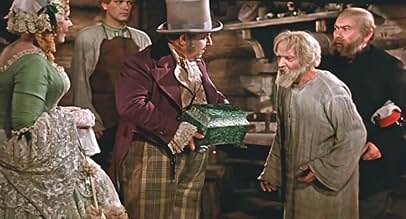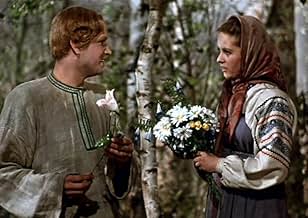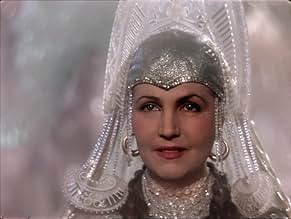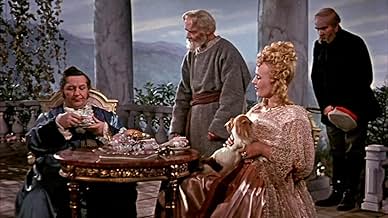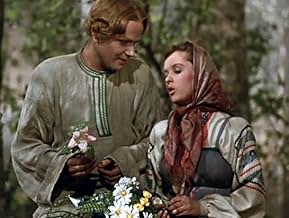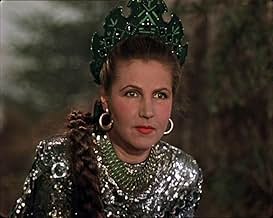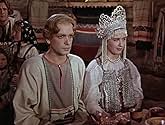NOTE IMDb
7,1/10
559
MA NOTE
Ajouter une intrigue dans votre langueObsessed with perfecting his craft, young gemcutter Danilo visits the mystical Copper Mountain to uncover the secret behind its infamous attraction - the Stone Flower, a stone carving so cap... Tout lireObsessed with perfecting his craft, young gemcutter Danilo visits the mystical Copper Mountain to uncover the secret behind its infamous attraction - the Stone Flower, a stone carving so captivating that no one can leave after seeing it.Obsessed with perfecting his craft, young gemcutter Danilo visits the mystical Copper Mountain to uncover the secret behind its infamous attraction - the Stone Flower, a stone carving so captivating that no one can leave after seeing it.
- Réalisation
- Scénario
- Casting principal
- Récompenses
- 2 victoires et 2 nominations au total
Vladimir Druzhnikov
- Danilo - master
- (as V. Druzhnikov)
Yekaterina Derevshchikova
- Katya
- (as Y. Derevshchikova)
Mikhail Troyanovskiy
- Prokopych
- (as M. Troyanovsky)
Mikhail Yanshin
- Severyan
- (as M. Yanshin)
Nikolay Temyakov
- Barin
- (as N. Temyakov)
Anna Petukhova
- Barina
- (as A. Petukhova)
Nikolai Orlov
- Stary master
- (as N. Orlov)
Lidiya Deikun
- Vikhorika
- (as L. Deikun)
Serafim Zaytsev
- Yefimka
- (as S. Zaytsev)
Vitaliy Kravchenko
- Danilo - malchyk
- (as V. Kravchenko)
Avis à la une
I saw The Stone Flower as somebody who really liked some of Aleksandr Ptusko's other films like Ruslan and Ludmilla, Sampo and Sadko(which is only to be seen in the original Russian version, the dub ruins it), and is having a great run of Russian fairy/folk-tale films. It was also highly recommended by commentators for those respective films, regarding it as one of his best/one of their favourites of his. I am happy that there are people who remember The Stone Flower very fondly, I am one of those newly-acquainted with it from Youtube rather than those who saw it in childhood. I am also glad that I saw it, as it really is as good as people say it is, and for me it is one of Ptushko's best. It is a gorgeous film to look at, the scenery is enough to take your breath away and the film is beautifully shot as well. It is very easy to be taken by the music score as well, because it does have a sense of fantasy and adventure, it sounds very Russian in its songs and its nationalistic feel, it is lusciously orchestrated and sometimes even sounds like a tender tone poem. The dialogue is well-incorporated within the story and sounds generally natural and sincerely delivered. The story is a magical one, it unfolds beautifully and packs a very powerful punch. It does move slowly particularly in the middle, but that is not a bad thing, if anything it gave the story a sense of freedom, time to breathe and allowed us to become invested in the characters and story and also admire the Russian culture. The characters all engage, especially the wicked Copper witch, they are fairy-tale clichés certainly but that is not to be taken as a bad thing. The acting is good, the hero is noble and sincere and the Copper Witch is both entrancing and icy. I personally didn't see the ending as that much of a cheat, there have been far worse ending cheats around. Though I do think also that The Stone Flower perhaps could've been even more powerful if ended tragically. All in all, magical. 10/10 Bethany Cox
For the commentator below, I thought I had seen it on tape but I'm not sure. Most probably saw it an art house in Chicago or some university festival (Roosevelt University had a very good one back then).
The film's use of color was a landmark breakthrough. It was a process different and superior to technicolor. We can do it today in say, Kodacolor, and "The Red Shoes" did indeed quite approximate it but good as that was, it did not equal SF,
I wonder if Martin Scorcese, who did a commentary for "The Red Shoe" saw it. I'm sure he would have been impressed and if someone could get to him today he might even promote putting it on DVD just for gras artis gras.
The film was of some importance politically too in that it was the first kind of cultural exchange gesture the Soviets made at the height of the cold war. We probably sent them "Gone With The Wind." I mean that.
The film's use of color was a landmark breakthrough. It was a process different and superior to technicolor. We can do it today in say, Kodacolor, and "The Red Shoes" did indeed quite approximate it but good as that was, it did not equal SF,
I wonder if Martin Scorcese, who did a commentary for "The Red Shoe" saw it. I'm sure he would have been impressed and if someone could get to him today he might even promote putting it on DVD just for gras artis gras.
The film was of some importance politically too in that it was the first kind of cultural exchange gesture the Soviets made at the height of the cold war. We probably sent them "Gone With The Wind." I mean that.
I saw The Stone Flower back in the forties shortly after it was released. I have never forgotten it. The color was so amazing that some of the images have remained permanently imprinted in my brain! I am disappointed that it is unavailable on video nor have I ever seen t revived anywhere where I have been. I am glad there are at least a few others who remember it.
10holcombe
I saw "The Stone Flower" in 1952 at Iowa State University's (then a state college) student union. I was a second or third grader, but I have never forgotten the magic of this Russian fable, the movie's gorgeous images and its powerful drama. I remember a wicked queen who turned the heroine into stone and the soft images of the lush rose-colored stone flower that remained for the hero to find after great struggles with the evil queen and her sinister minions.
Some sets were simple and rather bare. I like the earlier comment about "The Red Shoes," another post-war film from the recovering European film industries, with the same pre-war quality story lines and great effort to use color and images well, but with truly scarce resources.
I am so thrilled to find that others remember this wonderful film that seemed to have disappeared. I hope someone can find a print to share with film historians and certainly with other children. More than 50 years later, I can thank my mother for taking me to share the beautiful Stone Flower that I have never forgotten.
Some sets were simple and rather bare. I like the earlier comment about "The Red Shoes," another post-war film from the recovering European film industries, with the same pre-war quality story lines and great effort to use color and images well, but with truly scarce resources.
I am so thrilled to find that others remember this wonderful film that seemed to have disappeared. I hope someone can find a print to share with film historians and certainly with other children. More than 50 years later, I can thank my mother for taking me to share the beautiful Stone Flower that I have never forgotten.
The art direction and production design in the movie is really quite fetching. The physical film that was accordingly used to shoot 'The stone flower' resulted in rich, vibrant colors that allow every little trait to pop out brilliantly. Wonderful attention to hair, makeup, costume design, and set design and decoration, and every nuance of the cast's performances, is realized with inspiring vividness. Moreover, director Aleksandr Ptushko demonstrates a keen eye for arranging some fine shots, solid camerawork, and good care for lighting. And these are only just the visual aspects of what is an engaging, charming interpretation of a folk tale.
All the assembled actors put on fine displays of their skills to bring the picture to life, with Vladimir Druzhnikov especially notable as protagonist Danilo - believably portraying the young man's resolve, and obsession. Yet to discuss such facets at greater length seems unimportant when above all they serve simply as a component of the whole. It's the writing and direction that makes 'The stone flower' the entertaining classic that it is. Characters generally aren't written with especial depth, but like the acting, they work to complete the tableau. So it is too with the dialogue, very much feeling like the living communication of the sort of story that would be passed down over years - in no few ways a fable about the folly of pride, and ambition. And with that said, the fantastical scene writing and overall narrative are the greatest treasures here: terrifically entrancing, flush with detail and careful consideration, and enriching the entirety of the feature in their excellence. Druzhnikov matches the grand screenplay with adept focus and dexterity, tying the picture together with marvelous, expert finesse.
Factor in winsome set pieces, modest but suitable special effects - on par with any of the era - and gratifying instances of deftly arranged song and dance, and 'The stone flower' quite feels like it could be an early live-action production of Walt Disney's imagination. It's superb in its craft, and pleasantly endearing - really just an all-around lovely slice of cinema. If I have any specific criticism to make, it may perhaps be that the pacing struggles early on to find its footing. Yet for as splendidly well as the film is made, what slight deficiencies do crop up are negligible, and not truly significant. This is a magically, quietly engrossing movie, appropriate for all ages, that I think is surely very enjoyable for any viewer receptive to the type of story that it relates. I'd have no qualms recommending this to just about anyone - 'The stone flower' is a lot more fun, satisfying, and even rewarding than I thought it was going to be, and this is well worth checking out if you have the opportunity!
All the assembled actors put on fine displays of their skills to bring the picture to life, with Vladimir Druzhnikov especially notable as protagonist Danilo - believably portraying the young man's resolve, and obsession. Yet to discuss such facets at greater length seems unimportant when above all they serve simply as a component of the whole. It's the writing and direction that makes 'The stone flower' the entertaining classic that it is. Characters generally aren't written with especial depth, but like the acting, they work to complete the tableau. So it is too with the dialogue, very much feeling like the living communication of the sort of story that would be passed down over years - in no few ways a fable about the folly of pride, and ambition. And with that said, the fantastical scene writing and overall narrative are the greatest treasures here: terrifically entrancing, flush with detail and careful consideration, and enriching the entirety of the feature in their excellence. Druzhnikov matches the grand screenplay with adept focus and dexterity, tying the picture together with marvelous, expert finesse.
Factor in winsome set pieces, modest but suitable special effects - on par with any of the era - and gratifying instances of deftly arranged song and dance, and 'The stone flower' quite feels like it could be an early live-action production of Walt Disney's imagination. It's superb in its craft, and pleasantly endearing - really just an all-around lovely slice of cinema. If I have any specific criticism to make, it may perhaps be that the pacing struggles early on to find its footing. Yet for as splendidly well as the film is made, what slight deficiencies do crop up are negligible, and not truly significant. This is a magically, quietly engrossing movie, appropriate for all ages, that I think is surely very enjoyable for any viewer receptive to the type of story that it relates. I'd have no qualms recommending this to just about anyone - 'The stone flower' is a lot more fun, satisfying, and even rewarding than I thought it was going to be, and this is well worth checking out if you have the opportunity!
Le saviez-vous
- ConnexionsFeatured in Adieu l'URSS! (2021)
Meilleurs choix
Connectez-vous pour évaluer et suivre la liste de favoris afin de recevoir des recommandations personnalisées
Détails
- Durée1 heure 29 minutes
- Mixage
- Rapport de forme
- 1.37 : 1
Contribuer à cette page
Suggérer une modification ou ajouter du contenu manquant

